Analysis of Impact of a Novel Combined Casing Treatment on Flow Characteristics and Performance of a Transonic Compressor
Abstract
:1. Introduction
2. Model Description
3. Results
3.1. Effect of Combined CT on Transonic Compressor
3.1.1. Overall Performance
3.1.2. Flow Field Characterization
3.2. Entropy Generation Analysis
3.2.1. Analysis of Exchange Flow
3.2.2. Analysis of Loss Mechanism
3.2.3. Analysis of Loss Quantification
3.2.4. Parameter Analysis
4. Conclusions
Author Contributions
Funding
Institutional Review Board Statement
Informed Consent Statement
Data Availability Statement
Acknowledgments
Conflicts of Interest
Nomenclature
| modified efficiency | |
| required isentropic compression work, | |
| W | actual work done, |
| outlet pressure, | |
| inlet pressure, | |
| specific heat ratio | |
| inlet temperature, | |
| outlet temperature, | |
| temperature of the injection, | |
| mass flow rate of inlet, /s | |
| mass flow rate of outlet, /s | |
| mass flow rate of injection, /s | |
| pressure ratio near the stall point | |
| mass flow rate near the stall point | |
| pressure ratio near the peak efficiency point | |
| flow rate near the peak efficiency point | |
| relative total pressure coefficient | |
| relative total pressure, | |
| reference pressure, | |
| density of the fluid, | |
| speed of the blade tip, |
References
- Sun, X.; Dong, X.; Sun, D. Recent development of casing treatments for aero-engine compressors. Chin. J. Aeronaut. 2019, 32, 1–36. [Google Scholar] [CrossRef]
- Wennerstrom, A.J. Highly Loaded Axial Flow Compressors: History and Current Developments. J. Turbomach. 1990, 112, 567–578. [Google Scholar] [CrossRef]
- Hergt, A.; Meyer, R.; Engel, K. Effects of Vortex Generator Application on the Performance of a Compressor Cascade. ASME J. Turbomach. 2013, 135, 021026.1–021026.10. [Google Scholar] [CrossRef]
- Benini, E.; Biollo, R.; Ponza, R. Efficiency enhancement in transonic compressor rotor blades using synthetic jets: A numerical investigation. Appl. Energy 2011, 88, 953–962. [Google Scholar] [CrossRef]
- Ding, J.; Chen, S.; Xu, H.; Sun, S.J.; Wang, S.T. Control of Flow Separations in Compressor Cascade by Boundary Layer Suction Holes in Suction Surface. In Proceedings of the ASME Turbo Expo 2013: Turbine Technical Conference and Exposition, San Antonio, TX, USA, 3–7 June 2013; Volume 6A, Turbomachinery. pp. 35–52. [Google Scholar] [CrossRef]
- Tang, M.; Jin, D.; Gui, X. Modeling and numerical investigation of the inlet circumferential fluctuations of swept and bowed blades. J. Therm. Sci. 2017, 26, 1–10. [Google Scholar] [CrossRef]
- Houghton, T.; Day, I. Stability Enhancement by Casing Grooves: The Importance of Stall Inception Mechanism and Solidity. ASME J. Turbomach. 2012, 134, 021003.1–021003.8. [Google Scholar] [CrossRef]
- Chu, W.; Li, X.; Wu, Y.; Zhang, H. Reduction of end wall loss in axial compressor by using non-axisymmetric profiled end wall: A new design approach based on end wall velocity modification. Aerosp. Sci. Technol. 2016, 55, 76–91. [Google Scholar] [CrossRef]
- Benhegouga, I.; Yang, C. Numerical Simulation of Steady Air Injection Flow Control Effects on a Transonic Axial Flow Compressor. Appl. Mech. Mater. 2012, 224, 352–357. [Google Scholar] [CrossRef]
- Mao, X.C.; Liu, B.; Cao, Z.Y.; Zhang, P. Research on Corner Separation Control for Compressor Cascade with End-Wall Jet Flow. J. Propuls. Technol. 2014, 35, 1615–1622. [Google Scholar] [CrossRef]
- Li, J.; Du, J.; Geng, S.; Li, F.; Zhang, H. Tip air injection to extend stall margin of multi-stage axial flow compressor with inlet radial distortion. Aerosp. Sci. Technol. 2020, 96, 105554. [Google Scholar] [CrossRef]
- Yang, Q.; Li, L.; Zhao, Y.; Xiao, J.; Shu, Y.; Zhang, Q. Experimental investigation of an active control casing treatment of centrifugal compressors. Exp. Therm. Fluid Sci. 2017, 83, 107–117. [Google Scholar] [CrossRef]
- Wilke, I.; Kau, H. A Numerical Investigation of the Flow Mechanisms in a HPC Front Stage with Axial Slots. ASME J. Turbomach. 2004, 126, 339–349. [Google Scholar] [CrossRef]
- Danner, F.C.T.; Kau, H.P.; Mu¨ller, M.M.; Schiffer, H.P.; Brignole, G.A. Experimental and Numerical Analysis of Axial Skewed Slot Casing Treatments for a Transonic Compressor Stage. In Proceedings of the ASME Turbo Expo 2009: Power for Land, Sea, and Air, Orlando, FL, USA, 8–12 June 2009; Volume 7, Turbomachinery, Parts A and B. pp. 227–238. [Google Scholar] [CrossRef]
- Cravero, C.; Leutcha, P.J.; Marsano, D. Simulation and Modeling of Ported Shroud Effects on Radial Compressor Stage Stability Limits. Energies 2022, 15, 2571. [Google Scholar] [CrossRef]
- He, X.; Zheng, X. Roles and mechanisms of casing treatment on different scales of flow instability in high pressure ratio centrifugal compressors. Aerosp. Sci. Technol. 2019, 84, 734–746. [Google Scholar] [CrossRef]
- Zhang, H.G.; Chu, W.L.; Wu, Y.H. Mechanism of Influences of Axial Positions of Axial Skewed Slot CT on a Compressor Performance. J. Aerosp. Power 2011, 26, 92–98. [Google Scholar]
- Zhang, H.G.; Chu, W.L.; Wu, Y.H.; Deng, W.J.; Zhang, X. Mechanism of stall margin improvement associated with the blowing circumferential grooved casing treatment. J. Aerosp. Power 2007, 22, 961–966. [Google Scholar]
- Kim, D.W.; Kim, J.H.; Kim, K.Y. Parametric Study on Aerodynamic Performance of a Transonic Axial Compressor with a Casing Groove and Tip Injection. Appl. Mech. Mater. 2013, 284–287, 872–877. [Google Scholar] [CrossRef]
- Kim, J.-H.; Kim, D.-W.; Kim, K.-Y. Aerodynamic optimization of a transonic axial compressor with a casing groove combined with tip injection. Proc. Inst. Mech. Eng. Part A J. Power Energy 2013, 227, 869–884. [Google Scholar] [CrossRef]
- Dinh, C.-T.; Heo, M.-W.; Kim, K.-Y. Aerodynamic performance of transonic axial compressor with a casing groove combined with blade tip injection and ejection. Aerosp. Sci. Technol. 2015, 46, 176–187. [Google Scholar] [CrossRef]
- Fujita, H.; Takata, H. A Study on Configurations of Casing Treatment for Axial Flow Compressors. Bull. JSME 1984, 27, 1675–1681. [Google Scholar] [CrossRef] [Green Version]
- Koch, C.C.; Smith, L.H., Jr. Loss Sources and Magnitudes in Axial-Flow Compressors. J. Eng. Power 1976, 98, 411–424. [Google Scholar] [CrossRef]
- Sun, Y.; Ren, Y. Simulation and unsteady loss analyses of the flow in single-stage transonic compressor. Tsinghua Univ. (SciTech) 2009, 49, 759–762. [Google Scholar]
- Xi, N.; Le, L.; Ning, M.; Qian, L.; Feng, L. Numerical Investigation of Entropy Generation Distributions in a Transonic Compressor. In Proceedings of the ASME Turbo Expo 2016: Turbomachinery Technical Conference and Exposition, Seoul, Korea, 13–17 June 2016. [Google Scholar]
- Mu¨ller, M.W.; Schiffer, H.P.; Voges, M.; Hah, C. Investigation of Passage Flow Features in a Transonic Compressor Rotor With Casing Treatments. In Proceedings of the ASME 2011 Turbo Expo: Turbine Technical Conference and Exposition, Vancouver, BC, Canada, 6–10 June 2011; Volume 7, Turbomachinery, Parts A, B, and C. pp. 65–75. [Google Scholar] [CrossRef]
- Strazisar, A.J.; Wood, J.R.; Hathaway, M.D.; Suder, K.L. Laser anemometer measurements in a transonic axial-flow fan rotor. NASA Tech. Pap. 1989, NAS 1.60, 2879. [Google Scholar]
- Liu, Z.W.; Zhang, C.S.; Shi, J.X.; Wang, Z.S.; Huang, J.G. A study on effects of axial positions of skewed slots CT on compressor performance. J. Eng. Thermophys. 1987, 8, 52–54. [Google Scholar]
- Du, J.; Lin, F.; Zhang, H.; Chen, J. Numerical investigation on the self-induced unsteadiness in tip leakage flow for a transonic fan rotor. ASME J. Turbomach 2010, 132, 021017.1–021017.9. [Google Scholar] [CrossRef]
- Prince, D.C.; Wisler, D.D.; Hilvers, D.E. A Study of Casing Treatment Stall Margin Improvement Phenomena. In Turbo Expo: Power for Land, Sea, and Air, Proceedings of the ASME 1975 International Gas Turbine Conference & Products Show, Houston, TX, USA, 2–6 March 1975; American Society of Mechanical Engineers: New York, NY, USA, 1975. [Google Scholar] [CrossRef] [Green Version]
- Liu, J.X.; Yang, F.S.; Deng, J.Q.; Zhang, Z.X. Influence of Combined Casing Treatment on Flow Characteristics of Transonic Compressor. J. Xi’an Jiaotong Univ. 2020, 54, 173–178. [Google Scholar] [CrossRef]
- Wang, S.T.; Qiang, X.Q.; Feng, G.T.; Lin, W.C.; Wang, Z.Q. Study of low-reaction boundary layer suction axial compressor and it’s internal flow control. J. Eng. Thermophys. 2009, 30, 35–40. [Google Scholar]
- Ba, D.; Zhang, Q.; Du, J.; Li, Z.; Zhang, H.; Nie, C. Design optimization of axial slot casing treatment in a highly-loaded mixed-flow compressor. Aerosp. Sci. Technol. 2020, 107, 106262. [Google Scholar] [CrossRef]
- Lu, X.G.; Chu, W.L.; Zhu, J.Q.; Wang, R.G. Experimental and Numerical Investigation of a Subsonic Compressor with Bend Skewed Slots Casing Treatment. In Proceedings of the ASME Turbo Expo 2006: Power for Land, Sea, and Air, Barcelona, Spain, 8–11 May 2006. [Google Scholar]
- Chen, J.P.; Hathaway, M.D.; Herrick, G.P. Pre-stall behavior of a transonic axial compressor stage via time-accurate numerical simulation. J. Turbomach 2008, 130, 041014. [Google Scholar] [CrossRef] [Green Version]
- Brandstetter, C.; Wartzek, F.; Werner, J.; Schiffer, H.-P.; Heinichen, F. Unsteady Measurements of Periodic Effects in a Transonic Compressor with Casing Treatments. J. Turbomach. 2016, 138, 051007.1–051007.9. [Google Scholar] [CrossRef]
- Zhang, Q.; DU, J.; Li, J.; Zhao, M.; Zhang, H. Dual stability enhancement mechanisms of axial-slot casing treatment in a high-speed mixed-flow compressor with various tip clearances. Chin. J. Aeronaut. 2020, 34, 19–31. [Google Scholar] [CrossRef]
- Fan, L. Stall of an axial-compressor rotor with casing treatment. J. Aerosp. Power 2015, 30, 2647–2657. [Google Scholar] [CrossRef]
- Wu, W.; Zhao, J.; Zhong, J. Influence of the rotating direction and speed of controllable speed casing on the flow stability of a transonic compressor rotor under design condition. Aerosp. Sci. Technol. 2022, 126, 1270–9638. [Google Scholar] [CrossRef]
- Zhang, Q.; Du, J.; Li, Z.; Li, J.; Zhang, H. Entropy Generation Analysis in a Mixed-Flow Compressor with Casing Treatment. J. Therm. Sci. 2019, 28, 915–928. [Google Scholar] [CrossRef]
- Basak, T.; Singh, A.K.; Sruthi, T.A.; Roy, S. Finite element simulations on heat flow visualization and entropy generation during natural convection in inclined square cavities. Int. Commun. Heat Mass Transf. 2014, 51, 1–8. [Google Scholar] [CrossRef]
- Denton, J.D. Loss Mechanisms in Turbomachines; American Society of Mechanical Engineers: New York, NY, USA, 1993; Volume 78897, p. V002T14A001. [Google Scholar]
- Liu, R.Y.; Hou, A.P. Unsteady numerical study on flow control of axial skewed slots on compressor tip leakage vortex. Math. Comput. Model. 2019, 32, 8–15. [Google Scholar]



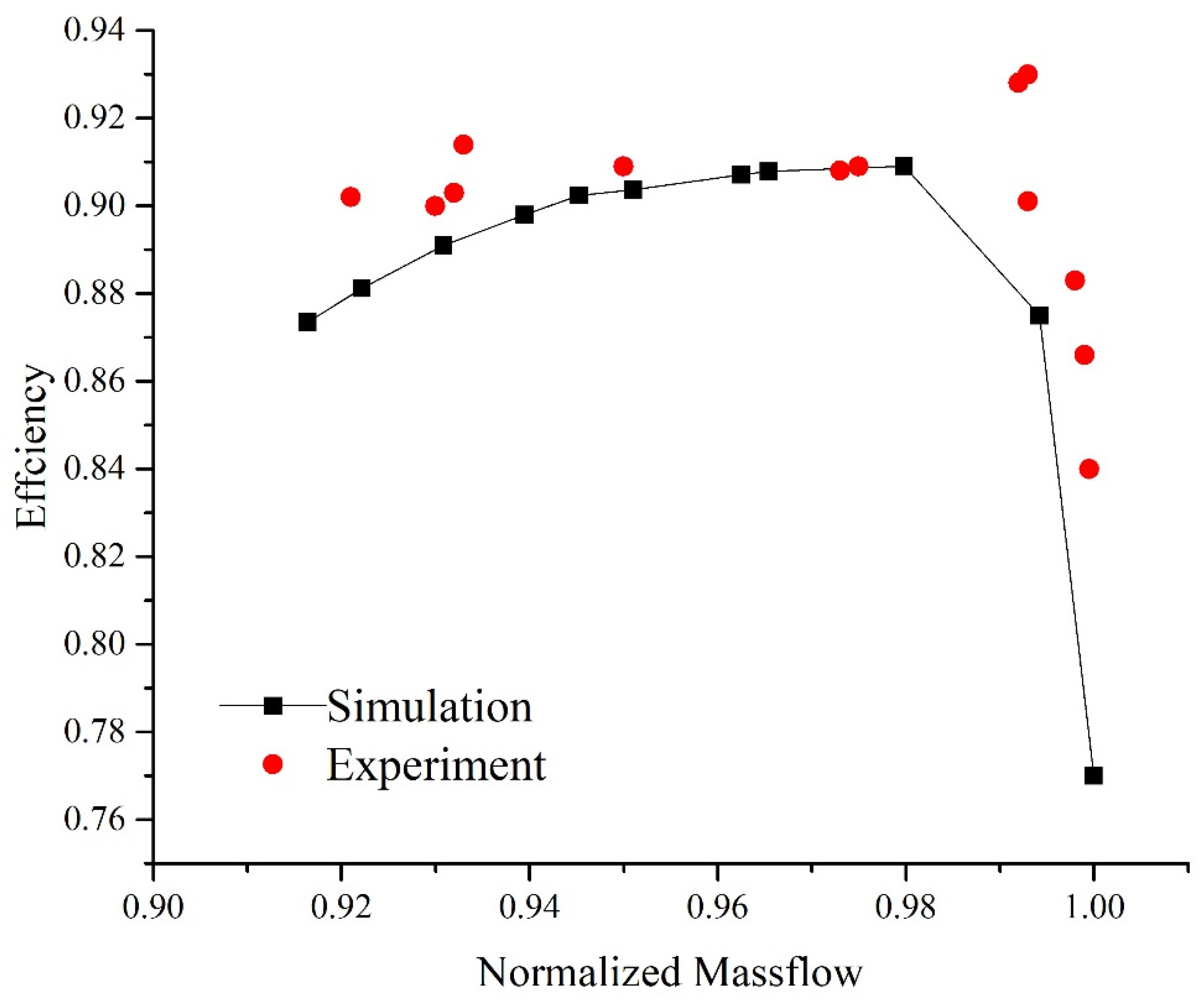
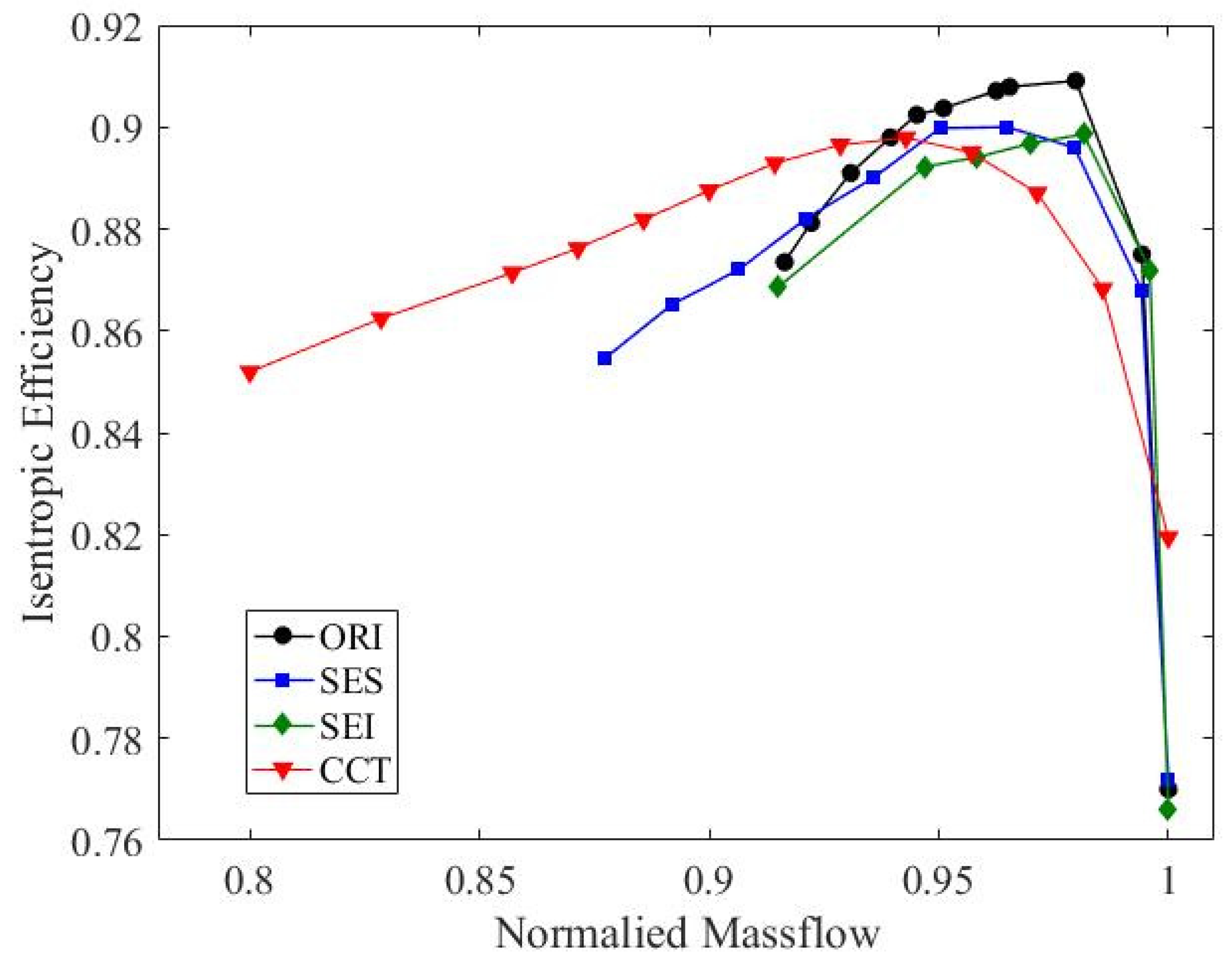

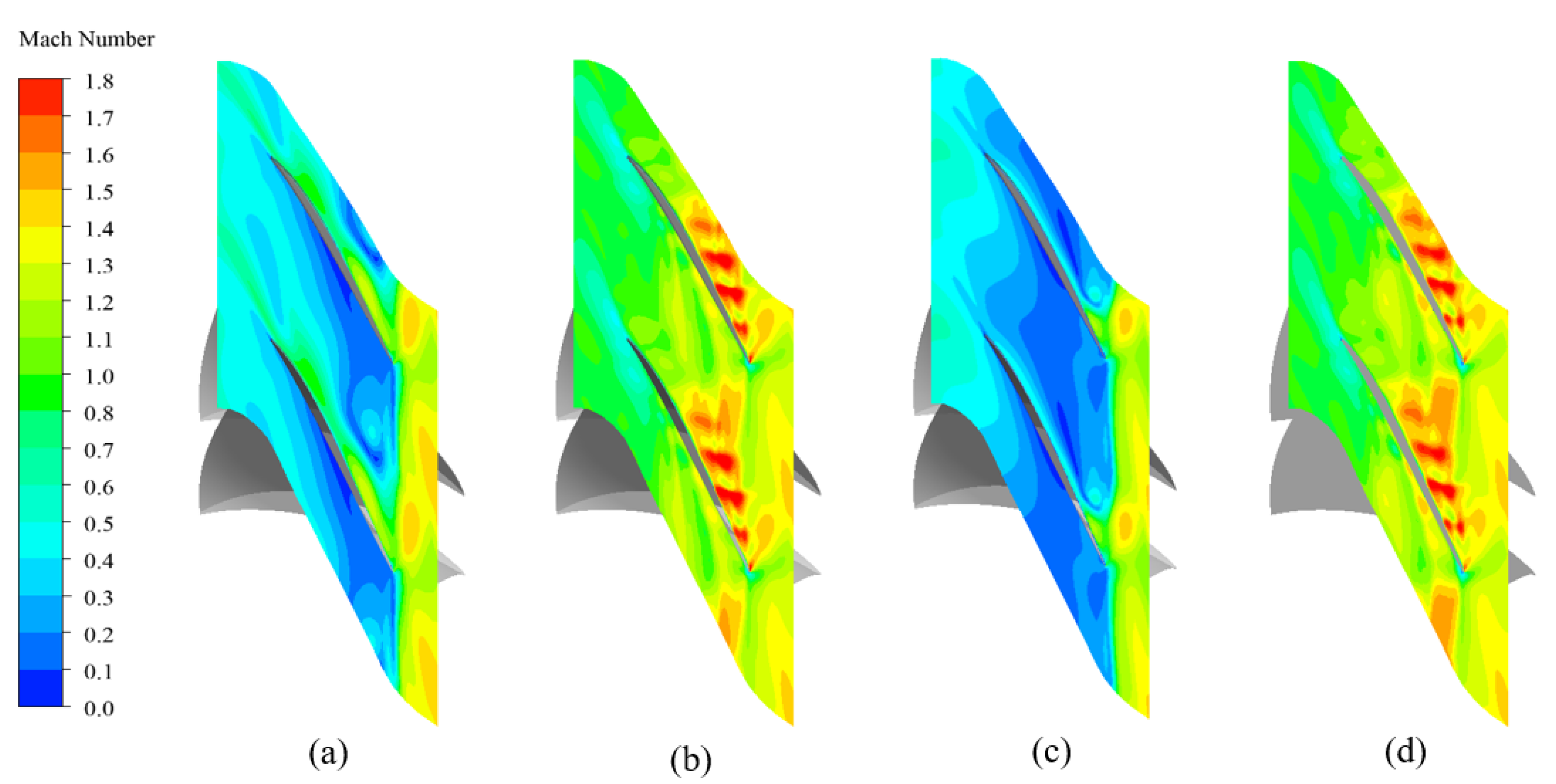
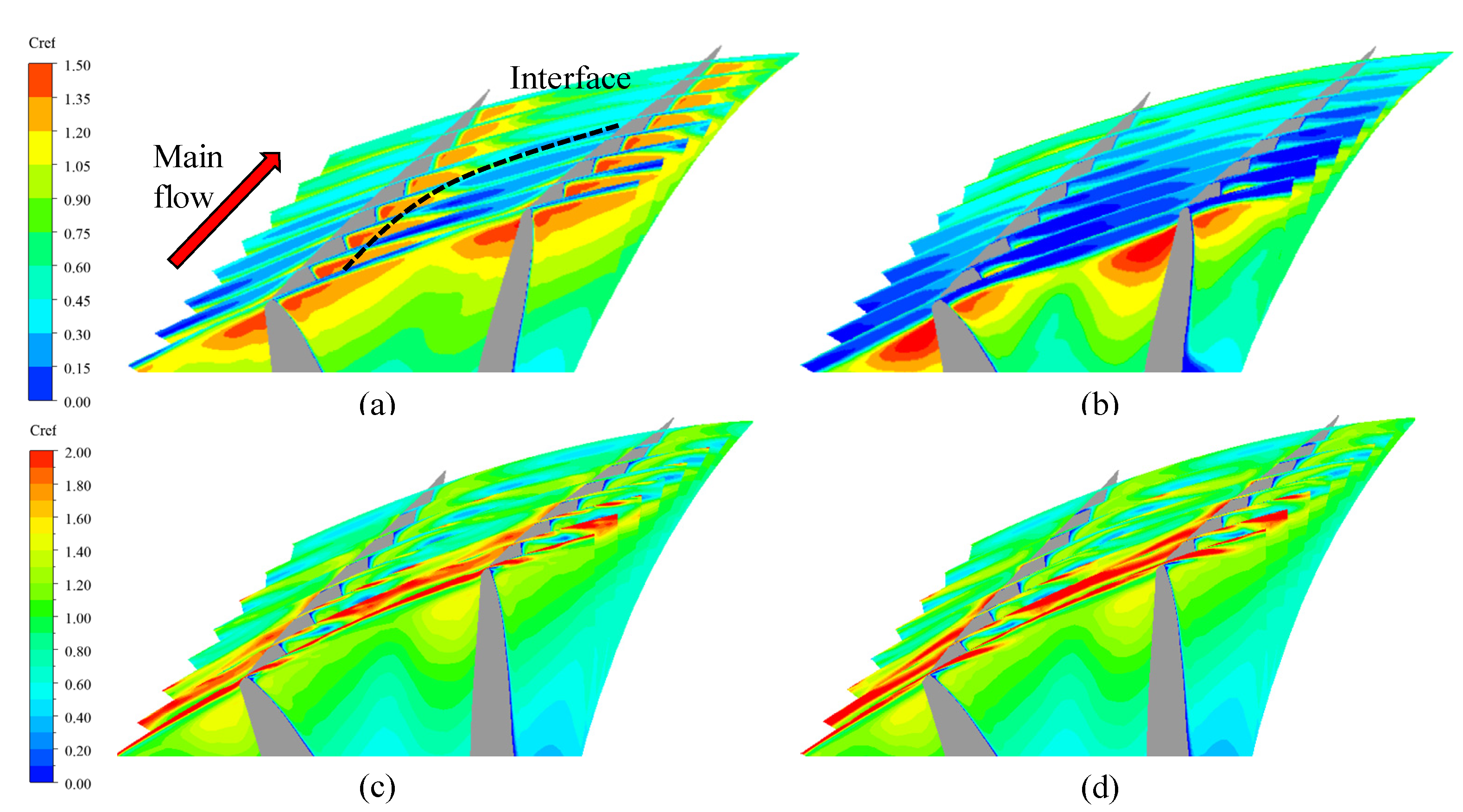



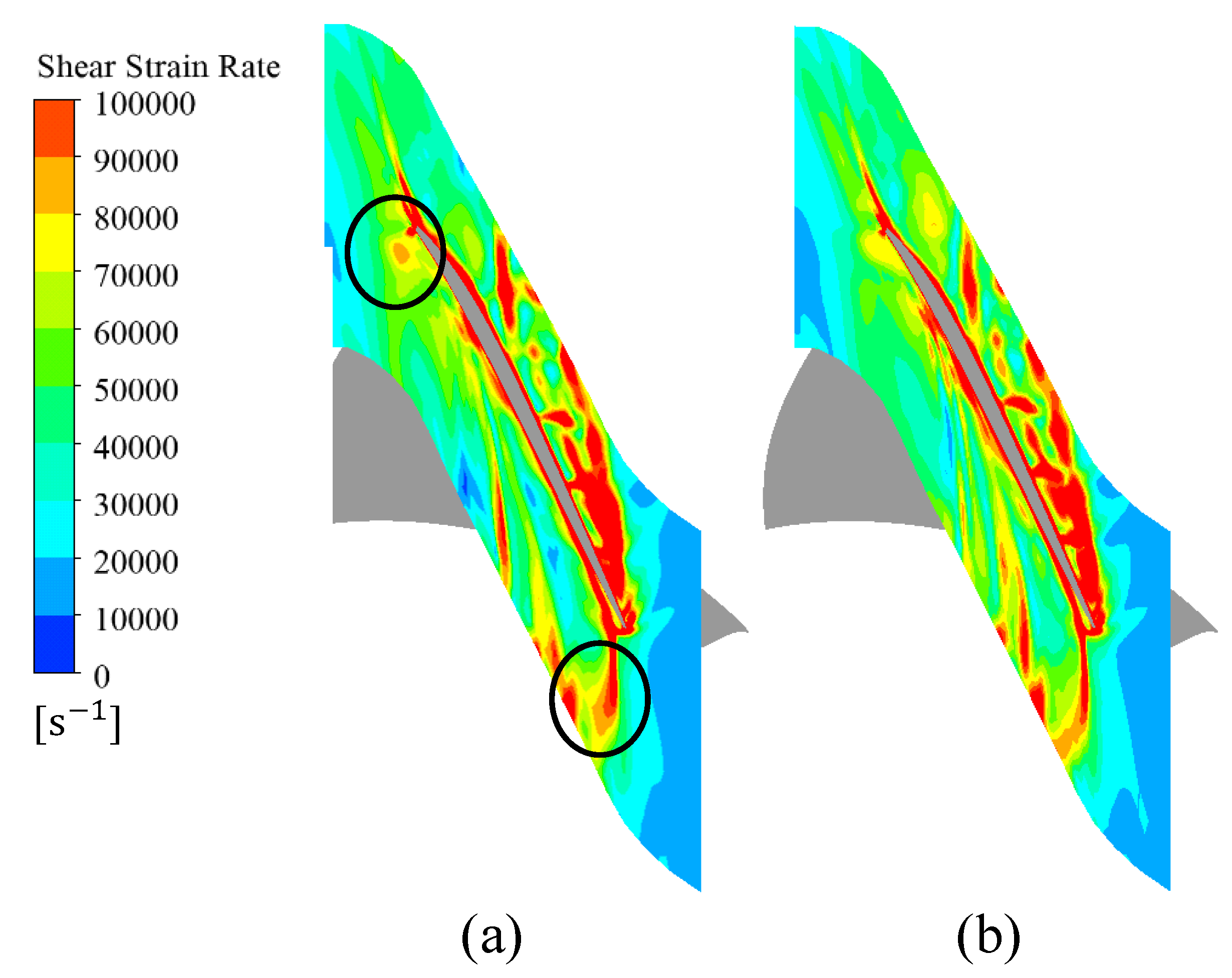


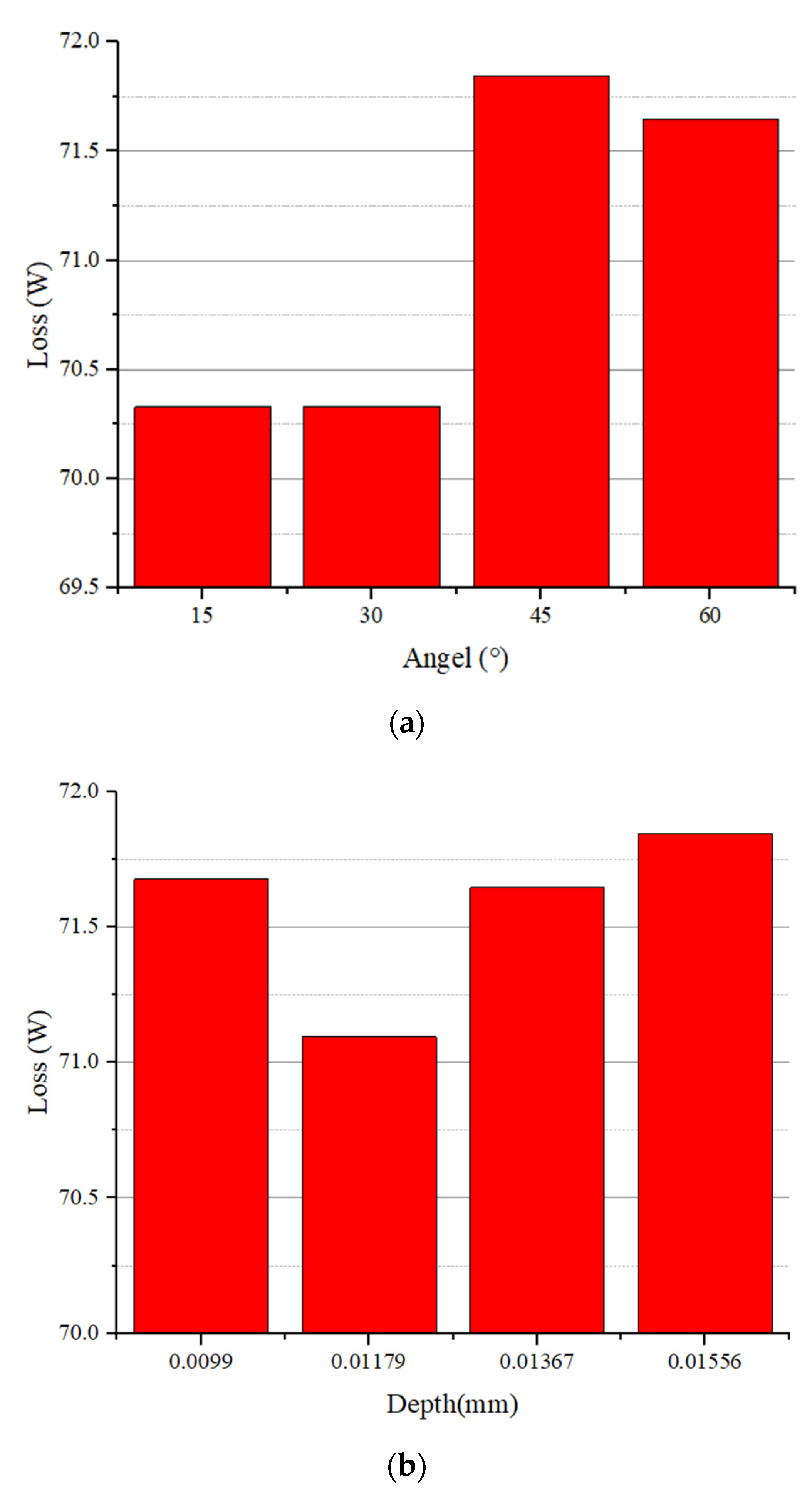
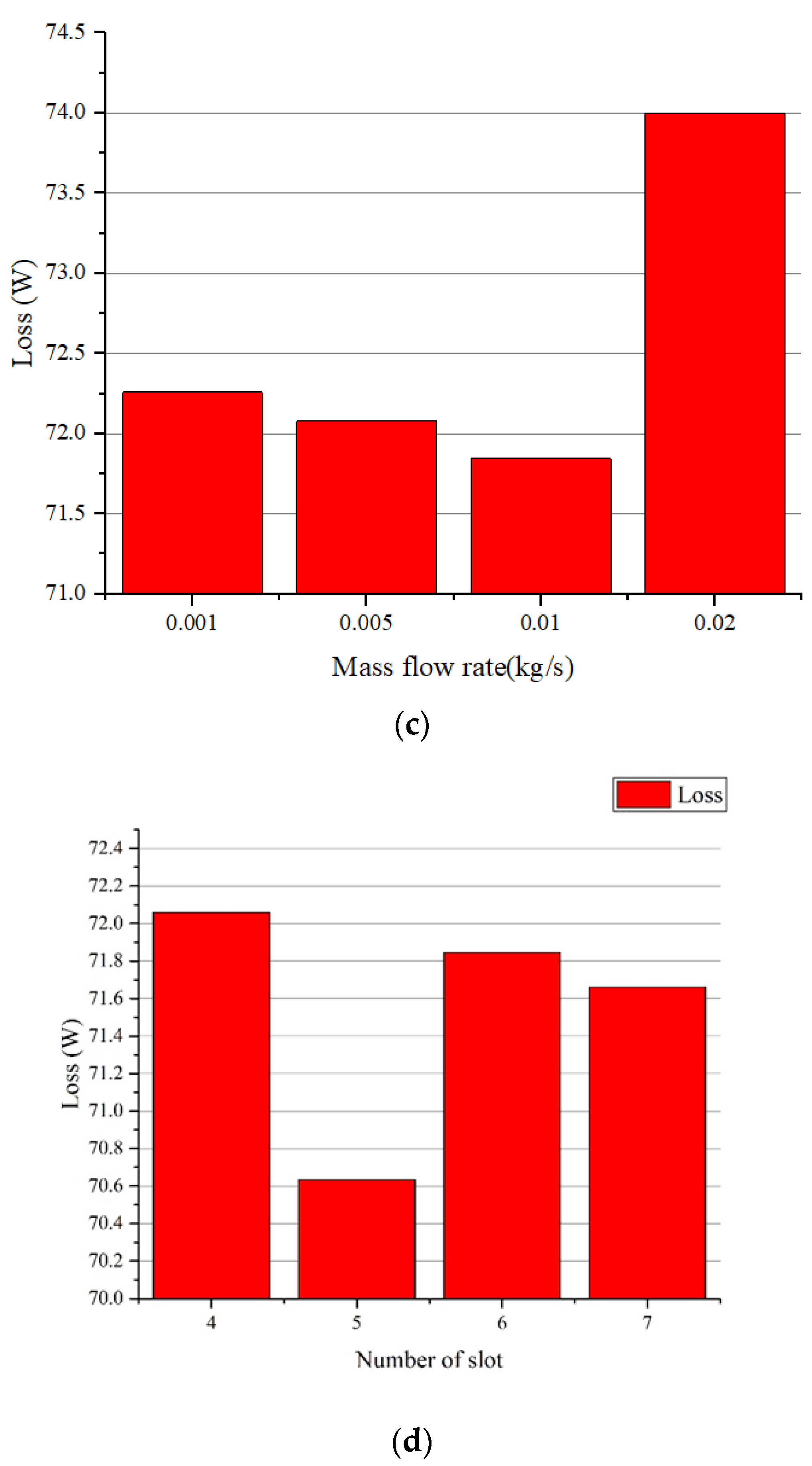
| Parameters | Value |
|---|---|
| Depth | 11 mm |
| Width | 3 mm |
| Number of slots | 6 |
| Area ratio of slot | 50% |
| Skewed angle | 45° |
| Up | Down | Main | Sum | |
|---|---|---|---|---|
| SES | −17.54% | 17.93% | 6.93% | 2.53% |
| CCT | −14.46% | 18.49% | 5.19% | 2.65% |
Publisher’s Note: MDPI stays neutral with regard to jurisdictional claims in published maps and institutional affiliations. |
© 2022 by the authors. Licensee MDPI, Basel, Switzerland. This article is an open access article distributed under the terms and conditions of the Creative Commons Attribution (CC BY) license (https://creativecommons.org/licenses/by/4.0/).
Share and Cite
Liu, J.-X.; Yang, F.-S.; Huo, T.-Q.; Deng, J.-Q.; Zhang, Z.-X. Analysis of Impact of a Novel Combined Casing Treatment on Flow Characteristics and Performance of a Transonic Compressor. Energies 2022, 15, 5066. https://doi.org/10.3390/en15145066
Liu J-X, Yang F-S, Huo T-Q, Deng J-Q, Zhang Z-X. Analysis of Impact of a Novel Combined Casing Treatment on Flow Characteristics and Performance of a Transonic Compressor. Energies. 2022; 15(14):5066. https://doi.org/10.3390/en15145066
Chicago/Turabian StyleLiu, Jia-Xuan, Fu-Sheng Yang, Tian-Qing Huo, Jian-Qiang Deng, and Zao-Xiao Zhang. 2022. "Analysis of Impact of a Novel Combined Casing Treatment on Flow Characteristics and Performance of a Transonic Compressor" Energies 15, no. 14: 5066. https://doi.org/10.3390/en15145066





